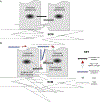Oral and intestinal bacterial exotoxins: Potential linked to carcinogenesis
- PMID: 32475520
- PMCID: PMC8258658
- DOI: 10.1016/bs.pmbts.2020.02.004
Oral and intestinal bacterial exotoxins: Potential linked to carcinogenesis
Abstract
Growing evidence suggests that imbalances in resident microbes (dysbiosis) can promote chronic inflammation, immune-subversion, and production of carcinogenic metabolites, thus leading to neoplasia. Yet, evidence to support a direct link of individual bacteria species to human sporadic cancer is still limited. This chapter focuses on several emerging bacterial toxins that have recently been characterized for their potential oncogenic properties toward human orodigestive cancer and the presence of which in human tissue samples has been documented. These include cytolethal distending toxins produced by various members of gamma and epsilon Proteobacteria, Dentilisin from mammalian oral Treponema, Pasteurella multocida toxin, two Fusobacterial toxins, FadA and Fap2, Bacteroides fragilis toxin, colibactin, cytotoxic necrotizing factors and α-hemolysin from Escherichia coli, and Salmonella enterica AvrA. It was clear that these bacterial toxins have biological activities to induce several hallmarks of cancer. Some toxins directly interact with DNA or chromosomes leading to their breakdowns, causing mutations and genome instability, and others modulate cell proliferation, replication and death and facilitate immune evasion and tumor invasion, prying specific oncogene and tumor suppressor pathways, such as p53 and β-catenin/Wnt. In addition, most bacterial toxins control tumor-promoting inflammation in complex and diverse mechanisms. Despite growing laboratory evidence to support oncogenic potential of selected bacterial toxins, we need more direct evidence from human studies and mechanistic data from physiologically relevant experimental animal models, which can reflect chronic infection in vivo, as well as take bacterial-bacterial interactions among microbiome into consideration.
Keywords: Bacterial exotoxins; Carcinogenesis; Colon cancer; Dysbiosis; Escherichia coli; Gut microbiota; Metabolites; Oral microbiome; Salmonella; β-Catenin/Wnt.
© 2020 Elsevier Inc. All rights reserved.
Figures

References
-
- Kuper H, Adami H-O, Trichopoulos D. Infections as a major preventable cause of human cancer. J Intern Med. 2000;248(3):171–183. - PubMed
-
- Plummer M, de Martel C, Vignat J, Ferlay J, Bray F, Franceschi S. Global burden of cancers attributable to infections in 2012: a synthetic analysis. Lancet Glob Health. 2016;4(9):e609–e616. - PubMed
-
- Hatakeyama M Helicobacter pylori CagA—a bacterial intruder conspiring gastric carcinogenesis. Int J Cancer. 2006;119(6):1217–1223. - PubMed
Publication types
MeSH terms
Substances
Grants and funding
LinkOut - more resources
Full Text Sources
Research Materials
Miscellaneous

